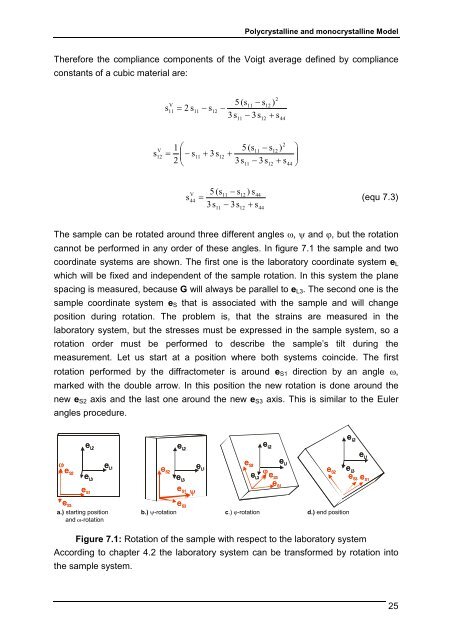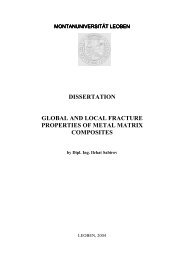Diploma Thesis - Erich Schmid Institute
Diploma Thesis - Erich Schmid Institute
Diploma Thesis - Erich Schmid Institute
Create successful ePaper yourself
Turn your PDF publications into a flip-book with our unique Google optimized e-Paper software.
Polycrystalline and monocrystalline Model<br />
Therefore the compliance components of the Voigt average defined by compliance<br />
constants of a cubic material are:<br />
s<br />
V<br />
12<br />
s<br />
V<br />
11<br />
=<br />
= 2 s<br />
11<br />
1 ⎛<br />
⎜<br />
⎜−<br />
s<br />
2 ⎝<br />
s<br />
11<br />
− s<br />
12<br />
+ 3s<br />
2<br />
5 ( s11<br />
− s12<br />
)<br />
−<br />
3s<br />
− 3s<br />
+ s<br />
12<br />
5 ( s<br />
11<br />
12<br />
44<br />
2<br />
5 ( s11<br />
− s12<br />
)<br />
+<br />
3s<br />
− 3s<br />
+ s<br />
− s<br />
11<br />
) s<br />
12<br />
44<br />
⎟ ⎞<br />
⎠<br />
V<br />
11 12 44<br />
44 = (equ 7.3)<br />
3s11<br />
− 3s12<br />
+ s44<br />
The sample can be rotated around three different angles ω, ψ and ϕ, but the rotation<br />
cannot be performed in any order of these angles. In figure 7.1 the sample and two<br />
coordinate systems are shown. The first one is the laboratory coordinate system eL<br />
which will be fixed and independent of the sample rotation. In this system the plane<br />
spacing is measured, because G will always be parallel to eL3. The second one is the<br />
sample coordinate system eS that is associated with the sample and will change<br />
position during rotation. The problem is, that the strains are measured in the<br />
laboratory system, but the stresses must be expressed in the sample system, so a<br />
rotation order must be performed to describe the sample’s tilt during the<br />
measurement. Let us start at a position where both systems coincide. The first<br />
rotation performed by the diffractometer is around eS1 direction by an angle ω,<br />
marked with the double arrow. In this position the new rotation is done around the<br />
new eS2 axis and the last one around the new eS3 axis. This is similar to the Euler<br />
angles procedure.<br />
a.) starting position b.) ψ-rotation c.) ϕ-rotation d.) end position<br />
and ω-rotation<br />
Figure 7.1: Rotation of the sample with respect to the laboratory system<br />
According to chapter 4.2 the laboratory system can be transformed by rotation into<br />
the sample system.<br />
25

















